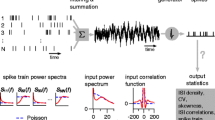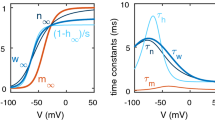Abstract
Irregular firing of action potentials (AP's) is a characteristic feature of neurons in the brain. The variability has been attributed to noise from various sources. This study illustrates an alternative mechanism, namely, deterministic irregularity within a model of ionic conductances. Specifically, a model based on modern measurements of the Na+ and K+ current components from the squid giant axon fires irregularly in response to a continuous train of near-threshold current pulses. The interspike interval histogram from these simulations is multi-modal, a result which in other systems has been attributed to stochastic resonance. Moreover, the simulations exhibited short burst of spikes followed by relatively long quiescent periods, a result suggestive of patterned input to the model even though the input consisted of a train of regularly spaced current pulses. The variability of firing is attributable to variations in AP parameters, in particular AP amplitude. The action potential for squid giant axons is not all-or-none. Rather, it is fundamentally a continuous function of stimulus amplitude. That is, the membrane lacks a threshold. Variation in AP amplitude, and to a lesser extent, AP duration, can produce variations in the time to a subsequent AP, which represents a paradigm shift for understanding irregular neuronal firing. The emphasis is not as much on events prior to an AP as it is on the AP's themselves.
Similar content being viewed by others
References
Abeles M, Bergman H, Gat I, Meilijson I, Seidmann E, Tishby N, Vaadia E (1995) Cortical activity flips among quasi-stationary states. Proc. Natl. Acad. Sci. USA 92: 8616-8620.
Adelman WJ, Fitzjugh R (1975) Solutions of the Hodgkin-Huxley equations modified for potassium accumulation in a periaxonal space. Fed. Proc. 34: 1322-1329.
Chik DTW, Wang YQ, Wang ZD (2001) Stochastic resonance in a Hodgkin-Huxley neuron in the absence of external noise. Phys. Rev. E 64: Art. no. 021913.
Clay JR (1977) Monte Carlo simulation of membrane noise: An analysis of fluctuations in graded excitation of nerve membrane. J. Theor. Biol. 64: 671-680.
Clay JR (1991) A paradox concerning ion permeation of the delayed rectifier potassium ion channel in squid giant axons. J. Physiol. 444: 499-511.
Clay JR (1998) Excitability of the squid giant axon revisited. J. Neurophysiol. 80: 903-913.
Clay JR (2000) Determining K+ channel activation curves from K+ channel currents. Eur. Biophys. J. 29: 555-557.
Clay JR, Shrier A (1999) On the role of subthreshold dynamics in neuronal signaling. J. Theor. Biol. 197: 207-216.
Clay JR, Shrier A (2001) Action potentials occur spontaneously in squid giant axons with moderately alkaline intracellular pH. Biol. Bull. 201: 186-192.
Clay JR, Shrier A (2002) Temperature dependence of bistability in squid giant axons with alkaline intracellular pH. J. Membrane Biol. 187: 213-233.
Cole KS, Guttman R, Bezaniila F (1970) Nerve membrane excitation without threshold. Proc. Natl. Acad. Sci. USA 65: 884-891.
Connor JA, Walter D, McKown R (1977) Neural repetitive firing: Modification of the Hodgkin-Huxley axon suggested by experimental results from crustacean axons. Biophys. J. 18: 81-102.
Ermentrout B (1996) Type I membranes, phase resetting curves, and synchrony. Neural Comp. 8: 979-1001.
Frankenhauser B, Hodgkin AL (1956) The after effects of impulses in the giant nerve fiber of Loligo. J. Physiol. 131: 341-376.
Gerstein GL, Mandelbrot B (1964) Random walk models for the spike activity of a single neuron. Biophys. J. 4: 41-68.
Goldman DE (1943) Potential, impedance, and rectification in membranes. J. Gen. Physiol. 27: 37-60.
Guckenheimer J, Oliva RA (2002) Chaos in the Hodgkin-Huxley model. SIAM J. Applied Dynamical Systems 1: 105-114.
Guttman R, Lewis S, Rinzel J. (1980) Control of repetitive firing in squid axon membrane as a model for a neuron oscillator. J. Physiol. 305: 377-395.
Hansel D, Mato G, Meunier C. (1995) Synchrony in excitable neural networks. Neural Comp. 7: 307-335.
Hodgkin AL, Huxley AF (1952) A quantitative description of membrane current and its application to conduction and excitation in nerve. J. Physiol. 117: 500-544.
Hodgkin AL, Katz B (1949) The effect of sodium ions on the electrical activity of the giant axon of the squid. J. Physiol. 108: 37-77.
Holt GL, Softky WR, Koch C, Douglas RJ (1996) Comparison of discharge variability in vitro and in vivo in cat visual cortex neurons. J. Neurophysiol. 75: 1806-1814.
Kaplan DT, Clay JR, Manning T, Glass L, Guevara MR, Shrier A (1996) Subthreshold dynamics in periodically stimulated squid giant axons. Phys. Rev. Lett. 76: 4074-4077.
Longtin A, Bulsara A, Moss F (1991) Time-interval sequences in bistable systems and the noise-induced transmission of information by sensory neurons. Phys. Rev. Lett. 67: 656-659.
Mainen ZF, Sejnowski TJ (1995) Reliability of spike timing in neocortical neurons. Science 268: 1503-1506.
Nowak LG, Sanchez-Vives MV, McCormick DA (1997) Influence of low and high frequency inputs on spike timing in visual cortical neurons. Cereb. Cortex 7: 487-501.
Reyes AD, Fetz EE (1993a) Two modes of interspike interval shortening by brief transient depolarizations in cat neocortical neurons. J. Neurophysiol. 69: 1661-1672.
Reyes AD, Fetz, EE (1993b) Effects of transient depolarizing potentials on the firing rate of cat neocortical neurons. J. Neuropphysiol. 69: 1673-1683.
Rinzel J, Miller R (1980) Numerical calculation of stable and unstable periodic solutions to the Hodgkin-Huxley equations. Math. Biosci. 49: 27-59.
Rudolph M, Destexhe A (2001) Do neocortical pyramidal neurons display stochastic resonance? J. Comp. Neurosci. 11: 19-42.
Shlesinger MF (2001) Physics in the noise. Nature 411: 641.
Siegel RM (1990) Non-linear dynamical system theory and primary visual cortical processing. Physica D 43: 385-395.
Steinmetz PN, Manwani A, Koch C, London M, Segev I (2000) Subthreshold voltage noise due to channel fluctuations in active neuronal membranes. J. Comp. Neurosci. 9: 133-148.
Vandenberg CA, Bezanilla F (1991) A sodium channel gating model based on single channel, macroscopic ionic, and gating currents in the squid giant axon. Biophys. J. 60: 1511-1533.
Wiesenfeld K, Moss F (1995) Stochastic resonance and the benefits of noise: From ice ages to crayfish and SQUIDS. Nature 373: 33-36.
Wolfram S (1999) The Mathematica Book, 4th ed. Wolfram Media/Cambridge Univ. Press, New York.
Author information
Authors and Affiliations
Rights and permissions
About this article
Cite this article
Clay, J.R. A Novel Mechanism for Irregular Firing of a Neuron in Response to Periodic Stimulation: Irregularity in the Absence of Noise. J Comput Neurosci 15, 43–51 (2003). https://doi.org/10.1023/A:1024470718603
Issue Date:
DOI: https://doi.org/10.1023/A:1024470718603




